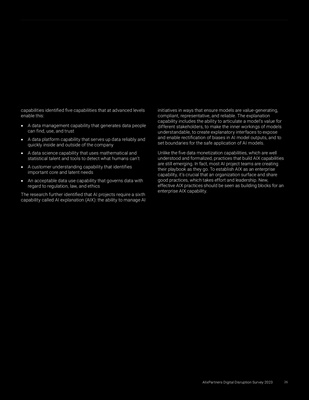
26 AlixPartners Disruption Index 2023
Monetizing data using AI
We asked MIT CISR to share how some companies are using AI to generate financial returns:
26 AlixPartners Disruption Index 2023
https://cisr.mit.edu/publication/2022_0601_AdvancedAICapabilities_WixomSomehBeath
https://cisr.mit.edu/publication/2021_0401_DataHeartsMinds_WixomOwensBeath
https://cisr.mit.edu/publication/2022_0701_AIX_SomehWixomBeath
https://cisr.mit.edu/publication/2020_1101_AI-Alignment_WixomSomehGregory
https://cisr.mit.edu/publication/MIT_CISRwp443SucceedingArtificialIntelligenceWixomSomehZutavernBeath
https://cisr.mit.edu/publication/MIT_CISRwp439_PepsiCoDX_Wixom
Large organizations increasingly aspire to monetize data using
AI, and many are succeeding. In MIT CISR case studies:
• GE's Corporate Environment, Health, and Safety (EHS)
team delivered company-wide governance and oversight
for the unit's area of focus. In 2016, a team of EHS leaders
wanted to improve a contractor onboarding process that
was exacting and labor intensive: hundreds of GE EHS
professionals vetted the approximately 80,000 contractors
the company hired annually. By 2020, GE had developed
and implemented an AI-enabled Contractor Document
Assessment (CDA) application that served all GE EHS
professionals as a bolt-on application for use during the
contractor onboarding process. Delivering the tool freed up
EHS professionals to focus more of their expertise on field
execution and higher-value EHS work.
• The Australian Taxation Office (ATO) was in 2020 one of the
largest government departments in Australia; it collected
$426 billion in net tax collections for the 2018-2019
financial year. In 2015, ATO launched the Smarter Data
program to increase its data analytics capabilities, and
beginning in the 2017 tax period, ATO's myTax system
included an AI-based nudging capability to support
compliant claim lodgment for work-related expenses.
During the 2018 tax period, nearly 240,000 taxpayers were
prompted, through a myTax pop-up message, to review
a specific label. The messaging resulted in taxpayers
adjusting the associated labels by around $113 million.
• At PepsiCo, one convenience store and gas (C&G) retailer
wanted to maximize sales of its fountain drinks, some of
which were PepsiCo's brands. The retailer did not know
how many people purchased which drinks because their
scan data only reflected the purchase of a cup, not its
contents. First, PepsiCo associates assembled data about
syrup purchases. Then, the team developed an ensemble
of machine learning models that identified specific store
and shopper attributes that influenced syrup usage. The
associates used this information to create ranked lists for
several different C&G store profiles; each list communicated
to the retailer which syrups were most important for
each specific profile. The customer implemented the
recommendations in late 2019 in over 1,000 stores and
began measuring the impact of the recommendations to
gauge next steps.
• At Cochlear, AI was used to offer a key mobile app
feature for its behind-the-ear sound processor (part of
an implantable hearing solution). The feature-called the
SCAN Scene Classifier-applied algorithms to analyze a
user's environment (e.g., crowded street corner, quiet room)
and automatically adjust the sound processor's settings
to deliver the best hearing for the conditions. Changes to
processor program settings had previously been made
manually by the patient, but product use data suggested
that patients might not have always chosen the optimal
settings for the situation. The developers created a scene
classifier algorithm that recognized distinct contexts and
made tailored processing adjustments.
Monetizing data using AI, however, requires extraordinary
capabilities. MIT CISR research into data monetization